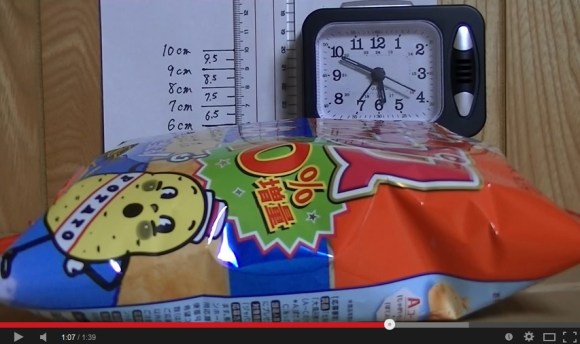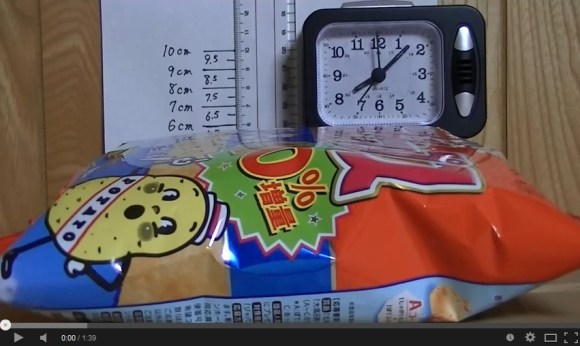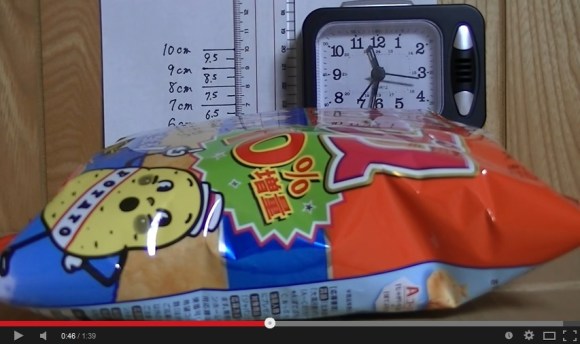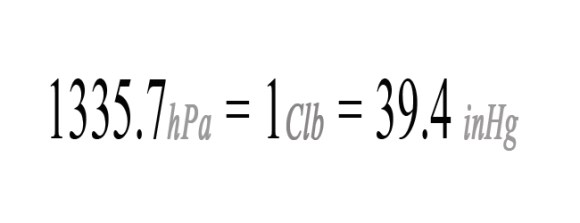
Some of you may recall the massive Typhoon Vongfong or Typhoon 19 in Japan passing straight across the country a couple weeks ago. The typhoon is said to have had an amazing minimum atmospheric pressure of 900 hectopascals (26.58inHg) at one point.
If you’re anything like us, we were left looking at those figures in awe of how much we don’t remember from our high school science classes. Luckily there’s an easier way to visualize the effect Typhoon 19 had on the air pressure thanks to this video on YouTube featuring an experiment that uses a scale everyone can understand: a bag of potato chips.
The video was said to have been made on a JVCEverio camcorder set to time-lapse mode for every 40 seconds over a 33-hour period from October 11 to October 12. During this time Typhoon 19 made its approach and passed over Okinawa.
A single bag of Calbee Potato Chips Lightly Salted Flavor with 10 percent added chips was place on a table along with a clock and ruler behind it. At the beginning of the video we can see the bag measures 5.7cm.
Then as time marches on the atmospheric pressure begins to drop. This allows the flavor pressure of the potato chips to push further outwards thus causing the bag to swell. At its peak, the bag reaches a thickness of 6.4cm.
Therefore, we can calculate the maximum atmospheric pressure change over Okinawa as 0.7 Calbees (700mClb). According to a report by MyNavi News based on information from tenki.jp, the atmospheric pressure at about 9:00am on 12 October, a couple of hours before the bag reached maximum thickness, was 935hPa.
So, we can assume a rough conversion for Calbees to hPa and inHg to be:
Of course, more experimentation with more accurate data will be needed to refine this constant. Nevertheless, this should suffice when you are stuck talking to people who refuse to abandon those stodgy old units based on poisonous metals or dead French guys.
Source: YouTube – Itomai, Karapaia, MyNavi News (Japanese)




 Experience an entire day at Tokyo Disneyland in just 110 seconds of time-lapse video
Experience an entire day at Tokyo Disneyland in just 110 seconds of time-lapse video Typhoon Lionrock delays production of Calbee potato chips
Typhoon Lionrock delays production of Calbee potato chips Japan’s new microwavable potato chips are amazing, but the best thing isn’t how they taste
Japan’s new microwavable potato chips are amazing, but the best thing isn’t how they taste Let’s talk about chips: Japanese netizens weigh in on the ten best potato chips in the country
Let’s talk about chips: Japanese netizens weigh in on the ten best potato chips in the country Microwavable potato chips go on sale in Japan, because why should we eat cold potatoes? 【Video】
Microwavable potato chips go on sale in Japan, because why should we eat cold potatoes? 【Video】 Beautiful new Final Fantasy T-shirt collection on the way from Uniqlo【Photos】
Beautiful new Final Fantasy T-shirt collection on the way from Uniqlo【Photos】 Disney princesses get official manga makeovers for Manga Princess Cafe opening in Tokyo
Disney princesses get official manga makeovers for Manga Princess Cafe opening in Tokyo Foreign English teachers in Japan pick their favorite Japanese-language phrases【Survey】
Foreign English teachers in Japan pick their favorite Japanese-language phrases【Survey】 Randomly running into a great sushi lunch like this is one of the best things about eating in Tokyo
Randomly running into a great sushi lunch like this is one of the best things about eating in Tokyo Hey, Japanese taxi driver! Take us to your favorite restaurant in Tsuruga City!
Hey, Japanese taxi driver! Take us to your favorite restaurant in Tsuruga City! New Japanese mascot character: A train station monster that grabs children who don’t mind the gap
New Japanese mascot character: A train station monster that grabs children who don’t mind the gap Enjoy viewing Kyoto’s cherry blossoms from above on a guided zipline tour
Enjoy viewing Kyoto’s cherry blossoms from above on a guided zipline tour How to properly eat a traditional Japanese tonkatsu meal
How to properly eat a traditional Japanese tonkatsu meal Kyushu-exclusive Black Mont Blanc goes nationwide in a “Special” way
Kyushu-exclusive Black Mont Blanc goes nationwide in a “Special” way Sakura season schedule is screwed up, so we had a no-cherry blossom cherry blossom party in the office
Sakura season schedule is screwed up, so we had a no-cherry blossom cherry blossom party in the office We try out “Chan Ramen”, an underground type of ramen popular in the ramen community
We try out “Chan Ramen”, an underground type of ramen popular in the ramen community New Studio Ghibli bedding sets are cool in all senses of the word
New Studio Ghibli bedding sets are cool in all senses of the word Our Japanese reporter visits Costco in the U.S., finds super American and very Japanese things
Our Japanese reporter visits Costco in the U.S., finds super American and very Japanese things New Pokémon cakes let you eat your way through Pikachu and all the Eevee evolutions
New Pokémon cakes let you eat your way through Pikachu and all the Eevee evolutions There’s a park inside Japan where you can also see Japan inside the park
There’s a park inside Japan where you can also see Japan inside the park Japanese convenience store packs a whole bento into an onigiri rice ball
Japanese convenience store packs a whole bento into an onigiri rice ball Hanton rice — a delicious regional food even most Japanese people don’t know about, but more should
Hanton rice — a delicious regional food even most Japanese people don’t know about, but more should Final Fantasy, Kingdom Hearts, and Dragon Quest pet product line announced by Square Enix
Final Fantasy, Kingdom Hearts, and Dragon Quest pet product line announced by Square Enix Studio Ghibli releases Kiki’s Delivery Service chocolate cake pouches in Japan
Studio Ghibli releases Kiki’s Delivery Service chocolate cake pouches in Japan Japan’s bone-breaking and record-breaking roller coaster is permanently shutting down
Japan’s bone-breaking and record-breaking roller coaster is permanently shutting down New definition of “Japanese whiskey” goes into effect to prevent fakes from fooling overseas buyers
New definition of “Japanese whiskey” goes into effect to prevent fakes from fooling overseas buyers Foreign passenger shoves conductor on one of the last full runs for Japan’s Thunderbird train
Foreign passenger shoves conductor on one of the last full runs for Japan’s Thunderbird train Kyoto bans tourists from geisha alleys in Gion, with fines for those who don’t follow rules
Kyoto bans tourists from geisha alleys in Gion, with fines for those who don’t follow rules Studio Ghibli unveils Mother’s Day gift set that captures the love in My Neighbour Totoro
Studio Ghibli unveils Mother’s Day gift set that captures the love in My Neighbour Totoro Domino’s Japan now sells…pizza ears?
Domino’s Japan now sells…pizza ears? Toyota built a life-sized Miraidon Pokémon and are letting people test drive it this weekend
Toyota built a life-sized Miraidon Pokémon and are letting people test drive it this weekend New Japanese KitKat flavour stars Sanrio characters, including Hello Kitty
New Japanese KitKat flavour stars Sanrio characters, including Hello Kitty Sales of Japan’s most convenient train ticket/shopping payment cards suspended indefinitely
Sales of Japan’s most convenient train ticket/shopping payment cards suspended indefinitely Sold-out Studio Ghibli desktop humidifiers are back so Totoro can help you through the dry season
Sold-out Studio Ghibli desktop humidifiers are back so Totoro can help you through the dry season Japanese government to make first change to romanization spelling rules since the 1950s
Japanese government to make first change to romanization spelling rules since the 1950s Ghibli founders Toshio Suzuki and Hayao Miyazaki contribute to Japanese whisky Totoro label design
Ghibli founders Toshio Suzuki and Hayao Miyazaki contribute to Japanese whisky Totoro label design Doraemon found buried at sea as scene from 1993 anime becomes real life【Photos】
Doraemon found buried at sea as scene from 1993 anime becomes real life【Photos】 Tokyo’s most famous Starbucks is closed
Tokyo’s most famous Starbucks is closed One Piece characters’ nationalities revealed, but fans have mixed opinions
One Piece characters’ nationalities revealed, but fans have mixed opinions We asked a Uniqlo employee what four things we should buy and their suggestions didn’t disappoint
We asked a Uniqlo employee what four things we should buy and their suggestions didn’t disappoint Princesses, fruits, and blacksmiths: Study reveals the 30 most unusual family names in Japan
Princesses, fruits, and blacksmiths: Study reveals the 30 most unusual family names in Japan Studio Ghibli’s new desktop Howl’s Moving Castle will take your stationery on an adventure
Studio Ghibli’s new desktop Howl’s Moving Castle will take your stationery on an adventure Green tea chocolate-covered potato chips arrive in Japan! 【Taste test】
Green tea chocolate-covered potato chips arrive in Japan! 【Taste test】 Which Japanese tube chip brand is the least disappointing upon opening? We measure to find out
Which Japanese tube chip brand is the least disappointing upon opening? We measure to find out Smelliest sushi in Japan to become potato chip flavor
Smelliest sushi in Japan to become potato chip flavor Man arrested for crimes against nature and potato chips, did it to meet popular voice actress
Man arrested for crimes against nature and potato chips, did it to meet popular voice actress Japanese potato chip maker to sell potato-growing kits
Japanese potato chip maker to sell potato-growing kits Strawberry chocolate shrimp chips: For when you want sweets plus seafood and/or are pregnant
Strawberry chocolate shrimp chips: For when you want sweets plus seafood and/or are pregnant Japanese snack food maker introduces new potato chips…for women!
Japanese snack food maker introduces new potato chips…for women! Sure eel flavored potato chips are great, but here’s a recipe that’ll make them even better!
Sure eel flavored potato chips are great, but here’s a recipe that’ll make them even better! Our natto maniac verifies the legitimacy of fermented soybean-flavored potato chips【Taste test】
Our natto maniac verifies the legitimacy of fermented soybean-flavored potato chips【Taste test】 Get ready for a cherry-blossom-flavored spring with Sakura Butter potato chips from Calbee!
Get ready for a cherry-blossom-flavored spring with Sakura Butter potato chips from Calbee! Calbee will have you clawing (literally) for their new cola-flavored chips
Calbee will have you clawing (literally) for their new cola-flavored chips We make chocolate-covered potato chips
We make chocolate-covered potato chips “Most luxurious consommé potato chips” on the way, flavored with wagyu, lobster, white wine
“Most luxurious consommé potato chips” on the way, flavored with wagyu, lobster, white wine New coffee-flavored potato chips “taste like chaos”
New coffee-flavored potato chips “taste like chaos” “Japanese steak sandwich” flavour potato chips have us slavering over our keyboards!
“Japanese steak sandwich” flavour potato chips have us slavering over our keyboards! Snack maker promises its extra-thick, extra-expensive potato chips are extra-delicious
Snack maker promises its extra-thick, extra-expensive potato chips are extra-delicious
Leave a Reply